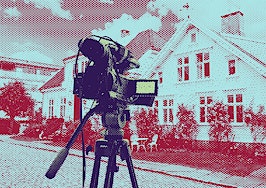Let’s face it, the iPhone is changing the way real estate agents do business — myself included. And even more importantly, it’s altering how we approach property marketing. Yes, we all know the drill: post on social media, get personal with your audience, track your SEO, and be sure to include video.
But what’s really interesting is the latest trend (thanks to COVID-19) of agents pivoting to do-it-yourself iPhone video to get a home sold. And it’s easy to see why. DIY iPhone video allows agents to get their message out fast and with ease.
Is a DIY iPhone video as useful as the pro versions? I think so.
Due to the pandemic, many agents are having to reinvent themselves. This includes investing in tech, buying the highest quality iPhone and taking the time to learn a new skill. If other industries are figuring it out, so can you. Don’t let DIY video scare you! I have proof of concept in this very post.
Below, you’ll find key pointers from the pros, and you’ll learn just how easy and effective it can be for an agent to create a solid property video without using all the gear and editing software or accumulating the sky-high fees of hiring a professional videographer.
DIY iPhone video tips you can use now

Trevor Thompson / Courtesy of The Address
Here are a few iPhone video tips, courtesy of Trevor Thompson with Abe1. He’s an expert in the field and part of a husband-and-wife duo that strives to create cinematic, high-quality content in both film and photography. By using Thompson’s iPhone video tips, my team has been able to harness the power of DIY property video like never before.
1. Check the camera settings on your iPhone
Thompson said in email, “Make sure your camera settings are set to ‘4k at 60 [fps or frames per second].’ This will allow for a sharper/cleaner looking video. You can also slow down the footage approximately 50 percent, which will help make everything look even smoother.”
2. Be sure to activate the ‘AE/AF Lock’ mode
When you are in the camera app, Thomas said to be sure to press and hold on the screen, which will activate AE/AF Lock mode.
“What this does is keeps a stable exposure and focus point, this way the camera isn’t changing exposures and focus points while you are filming,” he adds.
3. Use a wide-angle lens whenever possible
When in doubt, go wide angle.
“I love to use the wide-angle lens whenever possible,” Thompson said. “This will allow the space to look much bigger and open, much like when we shoot on our professional camera.”
4. Walk as slow and steady as you can
It should go without saying but be sure to walk as slow and as steady as you can. This will help for a smoother more appealing video. The best way to hone that skill? Practice, Thomson says.
And don’t forget to add music when applicable. There are programs out there such as Davinci Resolve that offer free versions that can help you enhance or edit your video as needed.

Courtesy of The Address
Get a glimpse of The Address’ DIY video journey
At The Address, we are always looking for new and creative ways to push the envelope. And diving headfirst into DIY video is one of these areas.
We co-listed and recently sold 1653 Bayside Drive in Newport Beach, California, in the midst of a pandemic. Part of the reason it sold? Video and digital marketing. This incredible beachfront property was listed for $11.65 million and to make a splash, between Janelle and Brandon File, The File Group and The Address, two professional videographers were commissioned to create compelling, attention-getting videos.
However, we also took matters into our own hands and created a DIY video using Trevor Thompson’s iPhone tips above. Here are the results:
1. Tri-Blend Video
This type of professional video can run you upward of a couple thousand dollars. It’s high-quality, visually stunning and a fantastic marketing option if you have the budget. The response I got after posting this article however, reminded me that most agents aren’t up for this the expense. I get it.
2. Prop Card Video
To be fair, here is another professional video of Bayside that captures the listing in a very different style and tone, proving just how distinct a final video product can be.
3. DIY iPhone Video
Agents, buyers and industry veterans agree that our DIY iPhone video using Trevor Thompson’s tips is a real winner. Not only were we able to create a video that is on par with the pro versions, but it was a fraction of the cost!
As you can see, all three videos offer a unique feel and vibe. However, each showcase the property in a positive light. And in my opinion, our DIY iPhone video is equally impressive. For those of you who are might not have the professional video budget, mastering iPhone property video is the cost-effective tool you need in your back pocket.
Are you for or against using iPhone video in your property marketing? Be sure to vote in the comments! I would love to hear your experiences.
Troy Palmquist is the founder and broker of The Address in Southern California. Follow him on Facebook, or connect with him on LinkedIn.













